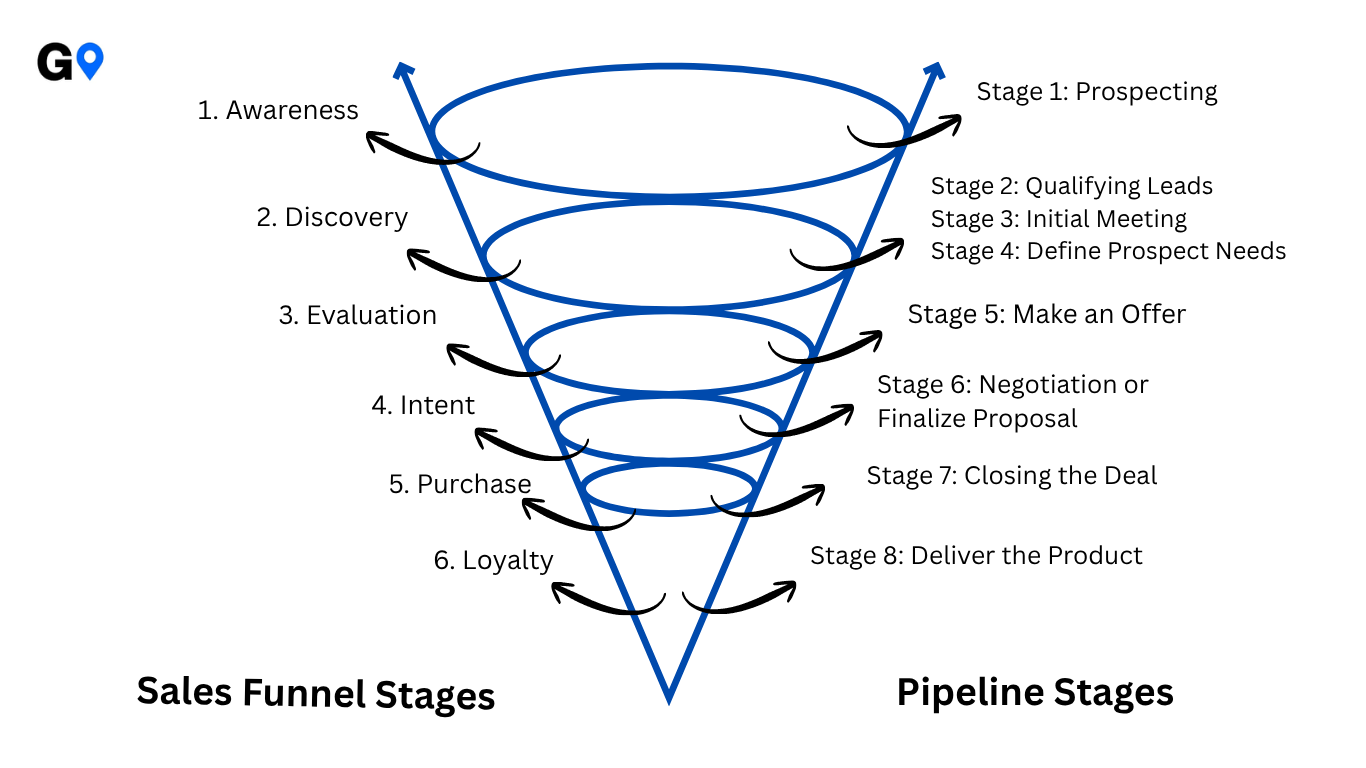
Mapping sales funnel stages to real-world pipeline actions helps business owners understand what happens and how it happens. As a strategic growth consultant, we at GetFound combine both models to build clarity, optimise performance, and drive consistent business growth for you.
If you need a deeper understanding of this topic, everything you need is below.
What Are Sales Funnel Stages?
Imagine you walk into a store just to look around, but something catches your eye. A friendly staff member offers help, and then you try the product, and before you know it, you have made a purchase. That journey? It is what marketers call a sales funnel, and it has stages.
The sales funnel is a model that describes the step-by-step journey your potential customer takes from first hearing about your business to finally making a purchase and ideally, becoming a loyal customer. It is called a “funnel” and is shaped like a funnel because it starts wide (lots of interest) and narrows down (only some convert into buyers).
To help guide our discussion, let’s take a closer look at the Sales Funnel Stages we will be diving into today:
Sales Funnel Stages to Pipeline Alignment
Here is how every stage of the sales funnel connects to practical pipeline steps you can start applying to drive results in your business:
| Sales Funnel Stages | Pipeline Stage(s) |
| 1. Awareness | Stage 1: Prospecting |
| 2. Discovery | Stage 2: Qualifying Leads
Stage 3: Initial Meeting Stage 4: Define Prospect Needs |
| 3. Evaluation | Stage 5: Make an Offer |
| 4. Intent | Stage 6: Negotiation or Finalise Proposal |
| 5. Purchase | Stage 7: Closing the Deal |
| 6. Loyalty | Stage 8: Deliver the Product |
1. Awareness → Stage 1: Prospecting
The sales funnel stages entry point is where your prospects meet your brand, like the first impression at a networking event. In the pipeline, you are casting a wide net, using strategies like cold emails, ad campaigns, and content that grabs the right people’s attention.
So, why does this stage matter so much? Simple: It is the golden opportunity to fill your funnel with leads before your competitors even say ‘hello.’ You have got to be the first to capture their attention if you want to build lasting relationships.
Expert Tip!
Think of cold outreach and SEO articles as your funnel’s version of an irresistible party invitation. With GetFound, we ensure your content is strategically placed to attract the right audience through top-of-funnel magnets. It is like prospecting, but way more fun and effective.
2. Discovery
Once your prospects take the bait, they move into the discovery stage. This is where things get interesting. It is like the first real conversation with someone at a party.
In the pipeline, your action steps in one of these sales funnel stages include:
Stage 2: Qualifying Leads
Why is this stage critical? Because it helps your business to see if they are the right fit:
- Are they ready?
- Do they have the need?
- Do they have the budget?
Think of it as ensuring you are talking to the right people at this stage.
Stage 3: Initial Meeting
Next up, it is all about booking those first meetings. These initial conversations are crucial; they lay the foundation for everything that comes after. This is where you get the chance to truly connect with your prospects, understand their needs, and start building trust.
This stage is for a productive partnership, and a well-planned first meeting can turn a curious lead into a committed prospect.
Stage 4: Define Prospect Needs
Refine the project scope and uncover pain points so everyone is aligned and ready to move forward.
Why does this matter? Combining marketing and sales touchpoints keeps prospects well-informed and genuinely interested in your work.
Practical qualification does not just help you convert more leads; it also saves you time by reducing effort on leads that are not ready to move forward. So, it is like working smarter, not harder. The best thing you can do is trust how GetFound works its magic, delivering it at the right time to the right people for you.
3. Evaluation → Stage 5: Make an Offer
At these sales funnel stages in the buyer journey, prospects are actively evaluating solutions, and this is where your proposal or product demo becomes critical. It is about listing features and clearly demonstrating how your solution directly aligns with their unique challenges, goals, and priorities.
Here, you answer their most challenging questions, address objections head-on, and show what your product does and why it matters to them.
The focus shifts to tangible value with real outcomes they can expect, ideally supported by:
- Case studies
- Metrics
- Success stories relevant to their industry
Expert Tip!
A well-structured, personalised proposal builds trust. According to recent B2B buyer behaviour studies in 2025, 72% of decision-makers say they are more likely to move forward with a solution when the proposal includes tailored business outcomes and ROI estimates.
In short, your proposal is not just a formality; it is your opportunity to position your solution as the clear, confident choice for accelerating purchase intent to your prospects.
4. Intent → Stage 6: Negotiation or Finalise Proposal
Right now, prospects are signaling strong purchase intent for your business. They have entered the negotiation phase, and proposals are being refined. This is your moment to shine!
Why is it crucial?
- At this stage, buyers are bringing objections and questions about pricing, contract terms, integration, and risk. According to Lead Forensics, 60% of customers will say “no” up to four times before saying “yes,” and handling objections can increase win rates by nearly 30%.
- Pricing is another hotspot. Nearly 38% of buyers oppose pricing modules, and 22% express concerns over ROI. These pushbacks can stall or even derail deals.
- Financial scrutiny is at an all‑time high. 57% of B2B software buyers expect to see ROI within three months, and 61% of legal or procurement teams slow or block purchases when contract terms do not align with policy.
What this means for you…
- Address objections proactively: Be ready to explain the “why” behind your pricing, show clear ROI narratives, and share success stories from similar clients.
- Negotiate smartly, do not give in: Offer flexibility on payment timing, contract length, or add-ons, but keep the focus on value, not just cost.
- Secure terms early: Agree on key deal points now, such as scope, pricing, and deliverables, so contract reviews do not cause surprises later.
How to Navigate Objections and Pricing Smoothly
- Listen and empathise, let prospects voice their concerns entirely.
- Validate and quantify the impact, such as “I get that price feels steep. Here’s how clients like you gain 4 to 6× ROI within six months.”
- Offer structured flexibility, phased payments, or optional services that reduce upfront cost.
- Anchor against value, not just price. Frame your price alongside long‑term gains and avoid costs.
- Move from draft to signature. Once objections are settled and terms refined, push confidently to finalise the agreement.
Using our expert insights for your business builds trust and quickly moves the deal from “maybe” to “yes.” So, act now!
5. Purchase → Stage 7: Closing the Deal
Deals are won, contracts are signed, and payments are processed, but your involvement in the sales funnel stages does not end here!
Why retention matters:
Because post‑sale momentum fuels future growth and opens doors for upsells and referrals. Here is why…
- Profit multiplier: Just a 5% increase in customer retention can boost profits by 25–95%, according to data from Bain & Company and industry surveys.
- Existing customers spend more: Repeat buyers are 50–67% more likely to purchase again and often spend significantly more per purchase than new customers.
- Cost-effective growth engine: Acquiring new clients is 5–7 times more expensive than retaining existing ones, making retention a far more efficient path to sustained revenue.
- Referral power: Loyal customers are 4× more likely to recommend others. B2B studies show referrals from happy customers enjoy 37% higher retention rates.
What this means for you…
- Your sales funnel stages job does not stop at payment. A strong onboarding and support system, from kickoff calls to proactive check-ins,s reinforces value and trust.
- Engaged customers are more open to expanding their relationship. Around 65% of B2B companies find upsells more successful with existing clients.
- Deliver remarkable experiences, and customers will not just stick with you; they will promote your brand. At least 60% of loyal users actively refer to friends and peers.
Need help designing a top-tier customer journey or metrics framework for your business? GetFound is happy to help!
6. Loyalty → Stage 8: Deliver the Product
This sales funnel stage encompasses onboarding, implementation, and ongoing support. Your primary goal is to exceed expectations, foster long-term relationships, and unlock referral opportunities.
Why is this stage critical?
- Customer retention begins with a strong start.
- Within SaaS, 75% of users abandon a product within the first week if onboarding falls short, and 55% quit if they do not quickly understand how it works.
- A smooth onboarding path dramatically reduces churn, and effective processes can double customer retention rates.
- Retention multiplies revenue
- A modest 5% lift in customer retention can increase profitability by 25–95%.
- Moreover, engaged customers deliver 1.7x more revenue; when employees and customers are engaged, revenue gains can reach 3.4x.
Expert Tips!
First 90 days are make-or-break, which means:
According to Gitnux, 70% of customer churn happens within 90 days, making early performance critical. Onboarding delays alone can increase churn by 35%.
Key Takeaways for Your Team
| Element | Why It Matters |
| Structured onboarding | Prevents early churn and establishes trust |
| Milestones & check-ins | Keeps clients engaged and tracks progress |
| Multi-channel support | Meets customers where they’re most comfortable |
| Personalized UX | Demonstrates care and relevance, increasing loyalty |
Next Steps!

Let’s talk about whether you’re ready to build a revenue engine powered by aligned sales funnel stages and actionable pipeline steps. GetFound – strategic growth consulting can help you transform prospects into predictable clients.
Do not wait any longer; our expert magic is right before you. Get started today!
For Deeper Learning:
- Learn more about our lead generation strategies
- Explore how we do sales pipeline consulting
- See how we help clients implement conversion-focused content
FAQ
Q: How long should each stage in the sales funnel last?
A: Pipeline timing varies. Prospecting may never end; discovery and evaluation typically last weeks in B2B.
Q: Should sales funnel stages and pipeline be maintained separately?
A: They are complementary. Funnel drives buyer behaviour, and pipeline defines your internal workflows. You can use CRM fields to track both for better insights.
Q: Can a prospect re-enter the funnel?
A: Definitely. B2B journeys are non-linear. Track re-engagements and adapt nurturing accordingly.







